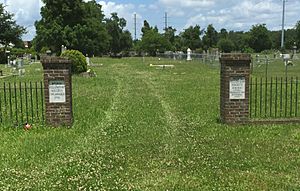Brown Fellowship Society facts for kids
The Brown Fellowship Society was a special club created in 1790 to help free African Americans in South Carolina. It was a self-help group, meaning its members supported each other. The group was later renamed the Century Fellowship Society and existed until 1945.
Contents
History of the Society
The Brown Fellowship Society was started in Charleston, South Carolina, in 1790. Its motto was “Charity and Benevolence,” which means kindness and helping others. It was founded by five free men of color: James Mitchell, George Bampfield, William Cattel, George Bedon, and Samuel Saltus.
At that time, churches run by white people often did not give African Americans the same support. The founders created the society to provide things their community needed. This included a proper burial ground, care for widows and orphans, and help for members who were sick.
Who Could Join the Society?
The society was exclusive. Members had to be "brown," a term used for people of mixed African and European ancestry, sometimes called mulattoes. In Charleston at the time, society was divided into three main groups: White, Mulatto, and Negro. This created complex social layers.
Joining the society was not easy. It had only about 50 members at first. A person had to pay a $50 fee, which was a lot of money back then. They also had to be approved in three separate votes. To keep the focus on helping each other, the group did not allow discussions about politics or religion during meetings.
What Did the Society Do?
The society's main goal was to create a cemetery for its members. They successfully bought land for a graveyard and a meeting house.
Beyond the cemetery, the society helped its members in many other ways:
- It took care of the widows and children of members who had passed away.
- It ran a primary school for the children of its members.
- It supported members' businesses.
- It worked to influence white leaders to get better treatment for their community.
Changes Over Time
After the American Civil War, the society began to change. It started to welcome more African Americans. This included women and people with darker skin. In 1892, the group officially changed its name to the Century Fellowship Society.
The society's end came in the 1940s. In 1943, the city of Charleston passed a law that stopped private groups from running their own cemeteries. Because of this new law, the Century Fellowship Society sold its graveyard in 1945 and the group was dissolved.
The Lost Graveyard
For many years, people believed that all the bodies had been moved from the old cemetery. But in 2001, a surprising discovery was made. While preparing to build a new library for the College of Charleston, workers found four graves. It turned out the entire cemetery had just been paved over.
Today, the historical records of the Brown Fellowship Society are kept safely at the Avery Research Center for African American History and Culture.
The Brotherly Society
In 1843, a free black man named Thomas Smalls wanted to join the Brown Fellowship Society. He was turned down because the members felt his skin was too dark.
In response, Smalls started his own group called The Society for Free Blacks of Dark Complexion. It was later renamed the Brotherly Society. He created a graveyard right next to the Brown Fellowship Society's cemetery for people of purely African descent. He also started another cemetery, which can still be seen today.


